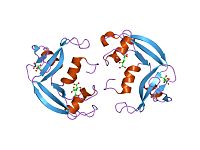
Photo from wikipedia
This study analyzed the nuclease- and serum-driven degradation of millimeter-scale, circular DNA–histone mesostructures (DHMs). DHMs are bioengineered chromatin meshes of defined DNA and histone compositions designed as minimal mimetics of… Click to show full abstract
This study analyzed the nuclease- and serum-driven degradation of millimeter-scale, circular DNA–histone mesostructures (DHMs). DHMs are bioengineered chromatin meshes of defined DNA and histone compositions designed as minimal mimetics of physiological extracellular chromatin structures, such as neutrophil extracellular traps (NETs). Taking advantage of the defined circular shape of the DHMs, an automated time-lapse imaging and image analysis method was developed and used to track DHM degradation and shape changes over time. DHMs were degraded well by 10 U/mL concentrations of deoxyribonuclease I (DNase I) but not by the same level of micrococcal nuclease (MNase), whereas NETs were degraded well by both nucleases. These comparative observations suggest that DHMs have a less accessible chromatin structure compared to NETs. DHMs were degraded by normal human serum, although at a slower rate than NETs. Interestingly, time-lapse images of DHMs revealed qualitative differences in the serum-mediated degradation process compared to that mediated by DNase I. Importantly, despite their reduced susceptibility to degradation and compositional simplicity, the DHMs mimicked NETs in being degraded to a greater extent by normal donor serum compared to serum from a lupus patient with high disease activity. These methods and insights are envisioned to guide the future development and expanded use of DHMs, beyond the previously reported antibacterial and immunostimulatory analyses, to extracellular chromatin-related pathophysiological and diagnostic studies.
Journal Title: International Journal of Molecular Sciences
Year Published: 2023
Link to full text (if available)
Share on Social Media: Sign Up to like & get
recommendations!